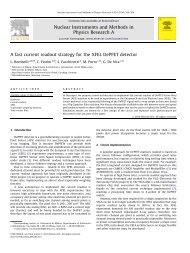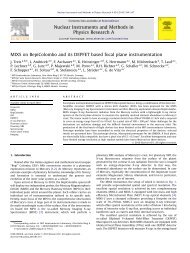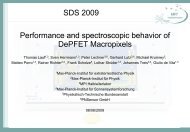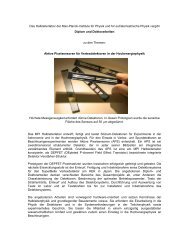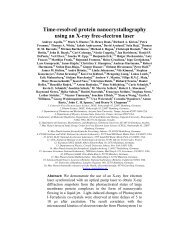4 / 5 Fig. 8. Energy spectrum of the Lyman transitions in kaonic hydrogen (background components are removed) resulting from the DEAR experiment [3]. Fig. 6. Foto of the Day-1 setup of SIDDHARTA showing the cryogenic gas target cell and the array of SDDs. Fig. 9. Monte Carlo simulation of the energy spectrum of kaonic hydrogen to be measured by the SIDDHARTA experiment. Compared with the DEAR experiment the SIDDHARTA experiment will improve the signal-to-background ratio by more than 2 orders of magnitude. This simulation <strong>for</strong> SIDDHARTA was per<strong>for</strong>med with an anticipated 5:1 signal-to-background ratio. Fig. 7. In SIDDHARTA a triple coincidence will be applied <strong>for</strong> background suppression (top). The light-weight crygenic gas target cell (bottom left) will be surrounded by the SDD array (bottom right). emitted charged kaon pair and the x ray is used <strong>for</strong> the suppression of uncorrelated background events (see Fig. 7). Cryogenic nitrogen is used as target gas filling because of the high x-ray yield. The kaonic nitrogen x-ray transitions first measured by the DEAR experiment will be used to study the background suppression as well as the energy resolution. In Fig. 7 below the main parts of the SIDDHARTA setup are displayed. The cryogenic hydrogen gas target consists of an aluminum grid structure with thin Kapton windows. The target will be operated at a temperature of 22 K and a working pressure of 2.5 bar. Up to 216 SDDs ordered in subunits will surround the cryogenic gas cell. The final setup of SID- DHARTA will be mounted in 2008. At the highest priority in the SIDDHARTA experiment are precision measurements of the x-ray spectra (K transitions) of kaonic hydrogen and kaonic deuterium [27]–[31]. An integrated luminosity of about 400 is planned to be used in the kaonic hydrogen measurement. The precision of the DEAR experiment was mainly limited by the poor signal-to-background ratio (1:100). This problem will be overcome with the SIDDHARTA setup. Monte-Carlo simulations show the excellent per<strong>for</strong>mance of SIDDHARTA (see Fig. 9)—in the case of kaonic hydrogen a signal-to-background ratio of 5:1 is the goal of this experiment. In the more difficult case of kaonic deuterium (the x-ray yield is by far lower, see Table I) a signal-to-noise ratio of 1:1 is anticipated. From the measured shift and width of the 1s state in kaonic hydrogen and deuterium the isospin-dependent scattering lengths can be extracted with unprecedented accuracy. <strong>New</strong> experimental in<strong>for</strong>mation about the kaon-proton interaction at threshold and the resonance—important <strong>for</strong> the research on deeply bound kaonic systems—will be provided. III. SUMMARY The potential of new x-ray detectors <strong>for</strong> exotic atom research was shown in an experiment at KEK <strong>for</strong> the first time. The
5 / 5 research on kaonic atoms provides insight in the low-energy antikaon-nucleon interaction. Long-standing puzzles were solved but precision experiments are highly requested to provide high quality data <strong>for</strong> a clear decision on different theoretical approaches. <strong>New</strong> experiments with large area SDDs are in preparation at LNF and at J-PARC. <strong>New</strong> x-ray detectors were developed which are anticipated to reach the goal of a precision in the eV range—thus a breakthrough in the antikaon physics at lowest energies is within reach. ACKNOWLEDGMENT This work is partly supported by the EU within Joint <strong>Research</strong> Activity 10 of I3-HadronPhysics and Transnational Access to <strong>Research</strong> Infrastructures Contract No.:RII3-CT-2004-506078. Gratefully acknowledged is the important contribution to the electronics by Giovanni Corradi and Diego Tagnani from LNF- INFN. REFERENCES [1] M. Iwasaki et al., Phys. Rev. Lett., vol. 78, p. 3067, 1997. [2] T. M. Ito et al., Phys. Rev., vol. 58, p. 2366, 1998. [3] G. Beer et al., Phys. Rev. Lett., vol. 94, p. 212302, 2005. [4] M. Cargnelli et al., Nucl. Instr. Meth. A, vol. 535, p. 389, 2004. [5] T. Ishiwatari et al., Nucl. Instr. and Meth. A, vol. 556, p. 509, 2006. [6] L. Strüder and H. Soltau, Radiation Protection Dosimetry, vol. 61, p. 39, 1995. [7] P. Lechner et al., Nucl. Instr. and Meth. A, vol. 377, p. 346, 1996. [8] W. Chen, H. Kraner, Z. Li, P. Rehak, E. Gatti, A. Longoni, M. Sampietro, P. Holl, J. Kemmer, U. Faschingbauer, B. Schmitt, A. Woner, and J. P. Wurm, IEEE Trans. Nucl. Sci., vol. 39, pp. 619–628, Aug. 1992. [9] J. S. Iwanczyk, B. E. Patt, C. R. Tull, J. D. Segal, C. J. Kenney, J. Bradley, B. Hedman, and K. O. Hodgson, IEEE Trans. Nucl. Sci. vol., vol. 46, pp. 284–288, Jun. 1999. [10] E. Gatti and P. Rehak, Nucl. Instr. and Meth. A, vol. 225, p. 608, 1984. [11] E. Gatti and P. Rehak, Nucl. Instr. Meth. A, vol. 541, p. 47, 2005. [12] S. Okada et al., Phys. Lett. B, vol. 653, pp. 387–391, 2007. [13] [Online]. Available: http://www.ketek.net [14] J. Marton, in Proceedings of International Symposium on Detector Development <strong>for</strong> Particle, Astroparticle and Synchrotron Radiation Experiments (SNIC 2006), Menlo Park, Cali<strong>for</strong>nia, Apr. 3–6, 2006, p. 0196. [15] J. Marton, in Proc. Workshop on <strong>Exotic</strong> Hadronic <strong>Atom</strong>s, Deeply Boundkaonic Nuclear States and Antihydrogen: Present Results, Future Challenges, European Centre <strong>for</strong> Theoretical Nuclear Physics and Related Areas (ECT*), Trento, Italy, Jun. 19–24, 2006. [16] M. Cargnelli et al., Canadian Journal of Physics, vol. 85, p. 479, 2007. [17] U.-G. Meißner, U. Raha, and A. Rusetsky, Eur. Phys. J. C, vol. 35, p. 349, 2004. [18] A. N. Ivanov et al., Eur. Phys. J. A, vol. 23, p. 79, 2005. [19] [Online]. Available: http://www.lnf.infn.it/esperimenti/siddharta [20] C. Fiorini and P. Lechner, IEEE Trans. on Nucl. Sci., vol. 46, no. 3, p. 761, 1999. [21] C. Fiorini and P. Lechner, IEEE Trans. on Nucl. Sci., vol. 49, no. 3, p. 1147, 1999. [22] C. E. Wiegand and R. H. Pehl, Pehl, Phys. Rev. Lett., vol. 27, p. 1410, 1971. [23] C. J. Batty et al., Nucl. Phys. A, vol. 326, p. 455, 1979. [24] S. Baird et al., Nucl. Phys. A, vol. 392, p. 297, 1983. [25] C. J. Batty, Nucl Phys. A, vol. 508, p. 89c, 1990. [26] Y. Akaishi, Proceedings of EXA 05, A. Hirtl, J. Marton, E. Widmann, and J. Zmeskal, Eds. Vienna: Austrian Academy of Sciences Press, 2005, p. 45. [27] J. Zmeskal et al., Proceedings of EXA 05, A. Hirtl, J. Marton, E. Widmann, and J. Zmeskal, Eds. Vienna: Austrian Academy of Sciences Press, 2005, p. 139. [28] M. Cargnelli et al., Int. J. Mod. Phys A, vol. 20, p. 341, 2005. [29] J. Marton, “Proc. XLV international winter meeting on nuclear physics,” in Ricerca Scientifica ed Educazione Permanente, Supp. N 127, I. Iori and A. Tarantola, Eds. : Dipartimento di Fisica, Universita degli Studi di Milano, 2007, p. 85. [30] J. Marton et al., “Proc. XLVI winter meeting on nucl. Physics,” in Ricerca Scientifica ed Educazione Permanente N.129, I. Iori and A. Tarantola, Eds. : Dipartimento di Fisica, Universita degli Studi di Milano, 2008, p. 121. [31] C. Curceanu (Petrascu) et al., EPJA, vol. 31, pp. 537–539, 2007.



